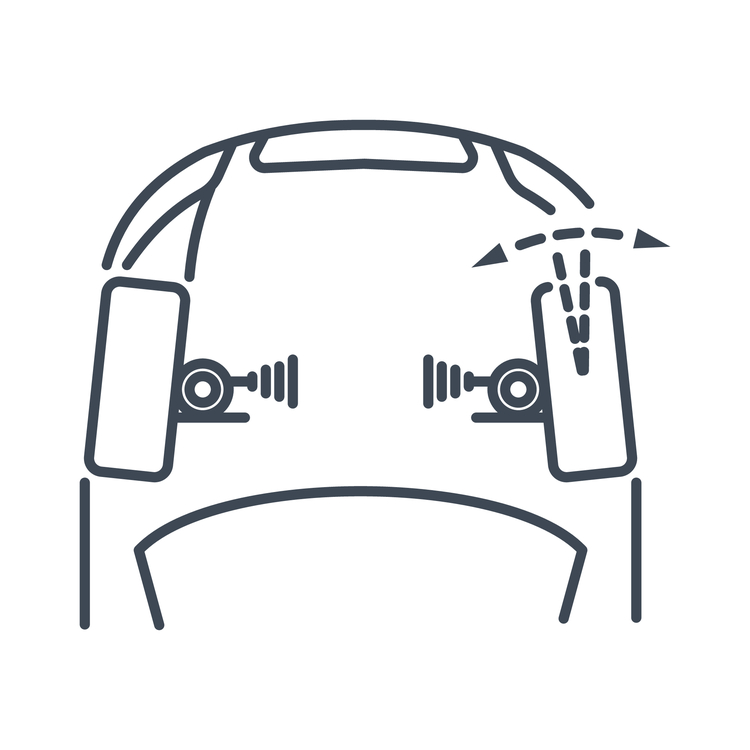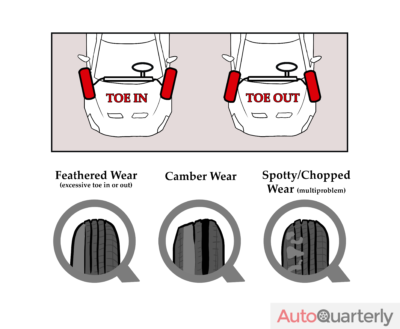Over time, the joints and components on your car loosen or wear out. When the components that hold the wheels on fall out of tolerance, it can make your car handle poorly or wear your tires out much quicker. To fix the problem, all cars have adjustable components that allow you to adjust the alignment of the wheels.
There are three main properties centered around wheel alignment: toe, camber, and caster. In this article, we’ll be looking at the toe adjustment. Toe is one of the easiest adjustments to understand; just look down at your feet. If your toes point in towards each other, that’s toe-in. If they point out away from each other, that’s toe-out.
What Is Toe?
Toe is a very simple concept, but it can be a little bit difficult to understand the effects it has on your car. To start, take a look at the following diagram. It shows toe-in, but it’s easy to imagine the reverse as well, which is toe-out.

The easiest way to understand how toe effects cars is to assume that a car wants to travel in the direction the tires face. When the two front tires point towards each other, the car wants to go straight (picture it like pushing your palms together). When they point out, your car wants to turn left or right.
Generally, you want your tires to be mostly parallel. Even more extreme setups only have differences measured in fractions of an inch. However, there are reasons you might want a little bit of toe-in or toe-out.
Toe-In vs. Toe-Out
Unlike caster and camber, which are expressed in positive or negative degrees, toe is often expressed as a simple distance measurement.
In industry terms, it’s the difference in track width as measured at the leading edge of a tire and the trailing edge of the tire. In practical terms, it’s a measurement that represents how far the wheels are turned in or away from each other.
The tires are considered to be pointed in if they angle in towards the car as the car moves forward. They are considered to be pointed out if they angle out away from the car. Sometimes, toe-in is considered positive, and toe-out is considered negative. That’s simply a way to keep all the alignment settings standardized.
How Toe Affects Driving
There are basically two ways that toe affects a car’s performance. Adjusting the toe can make your car handle better in the corners, or it can make it easier to keep the car straight on the highway.
The good news is that adjusting the toe angles is directly related to the car’s handling. That makes setting up your car fairly simple.
Toe-In for Stability
If you do primarily highway driving, or go on a lot of long road trips, you’ll want to have a little bit of toe-in. That will help keep your car going straight by resisting steering input. That has the added benefit of making longer drives more comfortable because minor road variations won’t translate to the steering wheel.
The downside is that you are sacrificing some cornering capability because your car will be resisting steering input. That’s especially noticeable at lower speeds because it lowers your steering angle.
What Is Steering Angle?
When you turn the steering wheel, there is a maximum amount of turning that can occur. That’s because there are some hard physical limitations. The steering arm only has so much room to move before, and the tires themselves only have so much space to turn back and forth.
The higher the steering angle, which is to say the more that the tires can turn, the better your car can take sharp corners at low speeds. Adjusting the wheels so that there is a little bit of toe-in reduces your steering angle. In essence, you are directly subtracting the toe-in angle from the steering angle because the wheel won’t be as turned when it hits the steering limits.
Toe-Out for Cornering
Cars are more stable and resist turning if you have a moderate amount of toe-in, so it follows that they have less turning resistance with some toe-out. Race cars and other vehicles that value performance over comfort will have some toe-out. That allows them to “snap” into a turn, and maximize turning angles.
The downside is that a car with toe-out can be a bit twitchy. When you make a car easier to steer, any minor movement of the steering wheel gets translated directly into a change in tire direction. Most people move their hands around a lot as they drive. Their hands get tired, or they need to reach for a drink, or they are shifting gears and they have to take their hands off the wheel for a second. You will feel the car move in that moment you release the wheel.
How Toe Affects Tire Wear
Excessive toe will wear down a tire more quickly than a properly aligned vehicle will. There are two ways that a tire will lose tread because of toe-in or toe-out. The first is very similar to castor issues; you’ll notice feathering.
The second is that the inside or outside of the tire will be worn down more than the opposing side, similar to what happens when you have excessive camber.
Feathering
Feathering can make a tire look like it has gills. When you look across the top of the tread, it should be even; all the tread blocks should be the same height. When a tire experiences excessive feathering, the tread will look jagged. This website has pictures of various types of tire wear if you would like to see it.
The biggest problem with feathering is that it can harm a tire’s ability to expel water. It’s certainly not the worst thing that can happen to a tire, but you will need to replace them sooner than a tire without feathering.
Inner or Outer Tread Wear
The inside of the tire is the side that is closest to the center of the car. If your car has excessive toe-out, the inside of the tire contacts the pavement before the rest of the tire, which causes it to wear out faster. Excessive inner-edge tread wear, especially on one side of your car but not the other, is a sure sign you need an alignment.
Toe-in has less effect on tread wear, although it may cause some outer-edge tread wear. It can be difficult to tell what issue you are having if you have some outer-edge tread wear since almost every alignment or tire issue causes the outside of a tire to wear down faster.
When to Adjust Toe
Your car’s service schedule will tell you when to check your alignment and what your factory toe angle is. Often, a commuter car will come from the factory with some toe-in. Most cars, however, will have a very neutral toe angle.
You may want to adjust your toe angle to a non-factory angle in order to bring out certain driving characteristics. Toe angle is adjusted in very small increments, so we encourage you to experiment with it a little. Add in some toe-in if you do a lot of highway driving, or give yourself a little toe-out for better handling. You might find you enjoy it a lot more than the factory settings.
Point Your Toes in the Direction of Stability
Keeping your car’s wheels aligned is an important part of the driving experience. Bad alignment is bad for your wallet, and it can detract from the enjoyment of keeping your car on the road. Don’t suffer from poor handling. Get the toe adjusted to suit your needs and enjoy those road miles.



